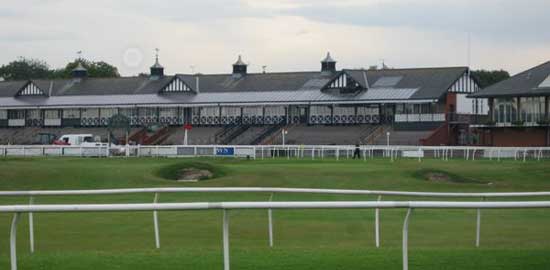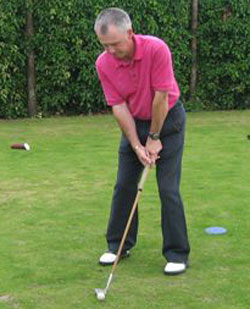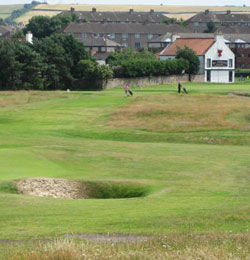Hickories at Musselburgh
Golfmagic member Sean McDonald re-discovers the origins of the game

In my capacity as a starter for the British Horseracing Authority, I have made many visits to Musselburgh Racecourse and as a keen golfer, I have always been intrigued by the nine-hole course inside the rails and its unique place in the history of our great game. So on my most recent racing trip I took some time out to play the course and learn more about its past and what plans it has for the future. Musselburgh Links Old Course has been in existence in various layouts since the 16th Century. Indeed Mary Queen of Scots is said to have played it in 1567, while there's written evidence of golf being played on these links in 1672. | |
Various societies or clubs would use the course as their home during the coming centuries until today where it remains the home of Musselburgh Old Course Golf Club whose knowledgeable and committed Secretary, Robin McGregor, gave me an insight into the past and what the future may hold. Six early Open Championships held here, the first in 1874 won by Mungo Park and the last in 1889 won by Willie Park Junior. These were played over four rounds of nine holes. In Willie Park’s year, play began at 10.30am and those players that were too far behind after 27 holes were offered five shillings (25p in modern money) not to play the remaining nine – an early form of tournament 'cut'. Many of golf's recognized forms of play began here and also the various rules we adhere to today. For instance, if you have ever wondered why a golf hole is 4.25 inches in diameter, Musselburgh has the answer. Local man, Robert Gray, devised a hole-cutting instrument in 1829 using a discarded piece of drainpipe with its interior measurement four-and-aquarter-inches wide. When the R & A was formed to standardise rules they used Gray's pipe as the benchmark because it could be easily copied by other courses. | |
At the end of the 19th century nearly 60 clubs and societies had their home links at Musselburgh but from the beginning of the 20th Century St Andrews’, as the star in the ascendency, effectively forced Musselburgh into the shadows. The advent of 18-hole courses meant it could not keep up with the demands of the modern golfer and they gradually drifted away. The links became neglected and merely provided a playground for local children. But in 1982 a group of enthusiasts formed the Old Course Golf Club and in tandem with the local authority, resurrecting the course and brought it back to a decent standard. "That work is on-going, " says Robin " and the club has devised a worldwide associate membership scheme to raise awareness of Musselburgh’s history and provide funds for future development." The nine hole layout lies within the confines of the racecourse and, apart from the order of play has remained unchanged since 1896. It looks innocuous at first glance but you quickly realise that the rough and particularly the gorse clumps can be penalising, the bunkers deep and the greens challenging! | |
I also chose the option of giving myself a further handicap by using hickory shafted clubs over the first nine holes. Several sets are available to rent to give visitors a taste of what it might have been like in Willie Park's era but without the added handicap of a feathery ball. I was warmly welcomed by the relief starter, a fellow Irishman, Paul Meegan, given a pencil bag with five traditional clubs - driver, long iron (with a 2-iron loft), 5-iron, niblick (wedge) and a putter. Joining me in the footsteps of those legends of the past were two Musselburgh members, Bob McMurtie and David Wilson. It was a strange sensation swinging that wooden-shafted 5-iron on the first tee. I caught the (modern) ball a little thin, which instantly gave me a painful reminder that my early season tennis elbow hadn’t quite cleared up. By the third hole as my fillings in my teeth were loosening and my eyeballs watered and turned to wobbly jelly! Whatever flex these hickory shafts had when they were made had long since vanished; I was playing with the period equivalent of super stiff. I could barely get the ball airborne and felt my current 13 handicap would hardly have reflected my flailing ability in the late 1800s. | |
I eventually managed to make half-decent contact and achieved one drive of about 170 yards. Everything tended to fly low and right which historically sounds appropriate as the brass plates on the clubs' soles were designed to help golfers get the ball back onto the course having sliced shots onto the road that runs alongside the fairways. Though I struggled with the longer shafted clubs I managed to almost master the niblick despite it having no 'bounce' built into the head and a leading edge that would take the whiskers off a '5 o'clock shadow'. As a result I hit some pretty handy bunker shots and took to the putter quite well. My nine hole score was a fairly unimpressive 55 embarrassing enough without snapping the shaft of a rather brittle driver on the 9th tee. I loved the leather grips - as good today as when they were made. Complete with modern clubs, including my beloved hybrids, powered trolley and even my GPS yardage device Iset off again on the second nine but this time I felt far more comfortable with my game. The course also played quite differently with hazards that might effect your second shot and now even in range from the tee. | |
However, the course still stood the test of time with course management as vital as it ever was. Indeed the final hole with a bunker flanking the fairway seemingly every ten yards after the 150 yard marker, demanded that only the most perfectly placed tee shot would find short grass. Fortunately my long pulled drive skirted the lot and from the rough found the green where two putts for par took my six-over par score to a respectable 40 strokes - an improvement of 15 shots compared to my nine holes with hickory. As I headed for the sanctuary of the 19th hole, I'm convinced the ghost of Willie Park looked on enviously at my gleaming metal clubs and shiny steel shafts, not to mentioned my motorised caddie. I'm sure, given similar equipment, the professionals of the 19th century would have given our dandy young pros a run for their money, too. I left to take up my duties for the evening meeting at the racecourse with nothing but admiration for the skills of those old pros, playing in tweed jackets and hob-nailed boots. The chance to step back upto 400 years in time and play Musselburgh with hickories is highly recommended. Several competitions - often in traditional costume - are organised throughout the year and full details can be found at the club's website www.mocgc.com or at www.musselburgholdlinks.co.uk, courtesy of East Lothian Council. Tell us on the forum your experiences of playing with hickory-shafted clubs and at the Musselburgh links.. |







